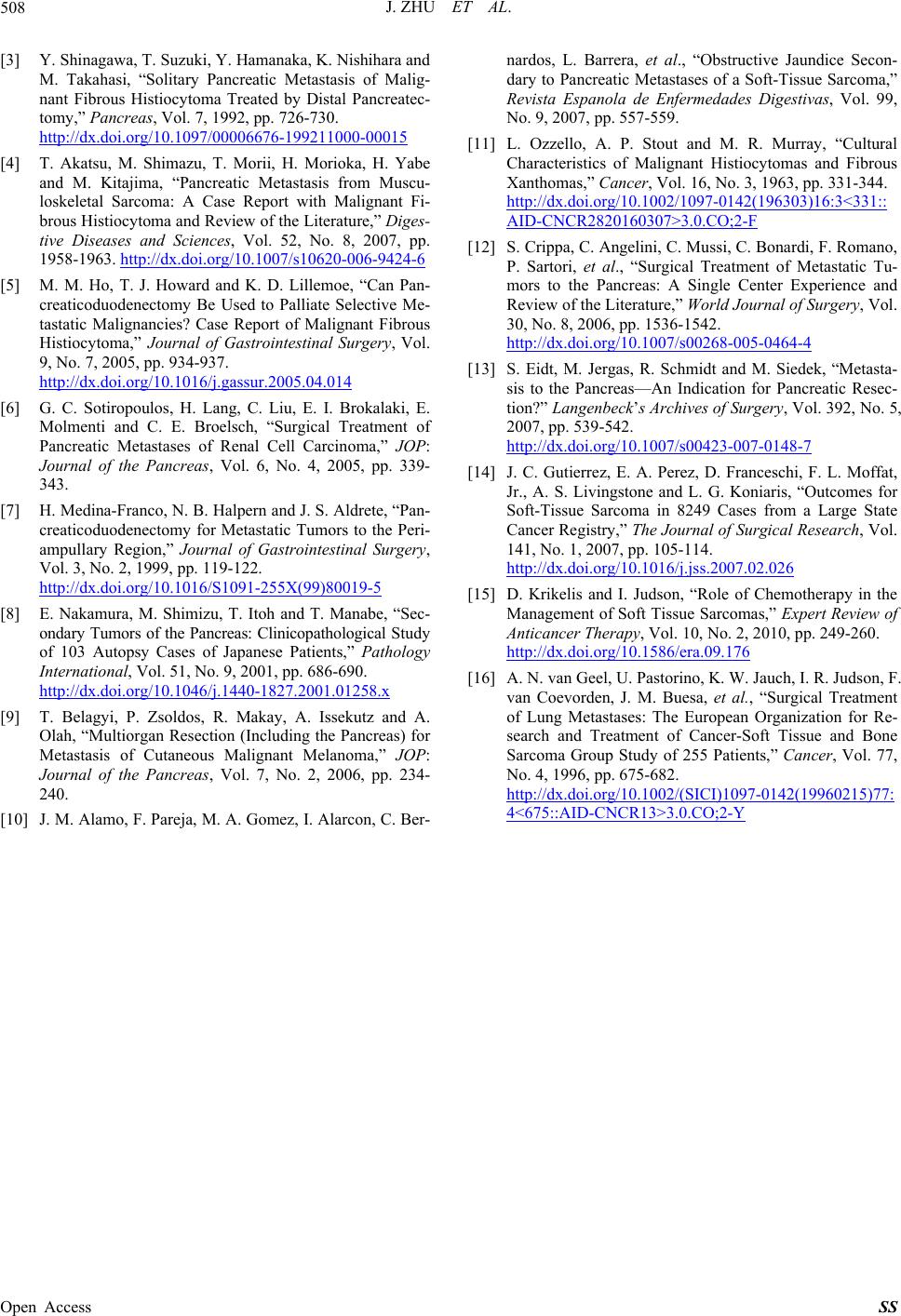
J. ZHU ET AL.
Open Access SS
508
[3] Y. Shinagawa, T. Suz uki , Y. Hamanaka, K. Nishihara and
M. Takahasi, “Solitary Pancreatic Metastasis of Malig-
nant Fibrous Histiocytoma Treated by Distal Pancreatec-
tomy,” Pancreas, Vol. 7, 1992, pp. 726-730.
http://dx.doi.org/10.1097/00006676-199211000-00015
[4] T. Akatsu, M. Shimazu, T. Morii, H. Morioka, H. Yabe
and M. Kitajima, “Pancreatic Metastasis from Muscu-
loskeletal Sarcoma: A Case Report with Malignant Fi-
brous Histiocytoma and Review of the Literature,” Diges-
tive Diseases and Sciences, Vol. 52, No. 8, 2007, pp.
1958-1963. http://dx.doi.org/10.1007/s10620-006-9424-6
[5] M. M. Ho, T. J. Howard and K. D. Lillemoe, “Can Pan-
creaticoduodenectomy Be Used to Palliate Selective Me-
tastatic Malignancies? Case Report of Malignant Fibrous
Histiocytoma,” Journal of Gastrointestinal Surgery, Vol.
9, No. 7, 2005, pp. 934-937.
http://dx.doi.org/10.1016/j.gassur.2005.04.014
[6] G. C. Sotiropoulos, H. Lang, C. Liu, E. I. Brokalaki, E.
Molmenti and C. E. Broelsch, “Surgical Treatment of
Pancreatic Metastases of Renal Cell Carcinoma,” JOP:
Journal of the Pancreas, Vol. 6, No. 4, 2005, pp. 339-
343.
[7] H. Medina-Franco, N. B. Halpern and J. S. Aldrete, “Pan-
creaticoduodenectomy for Metastatic Tumors to the Peri-
ampullary Region,” Journal of Gastrointestinal Surgery,
Vol. 3, No. 2, 1999, pp. 119-122.
http://dx.doi.org/10.1016/S1091-255X(99)80019-5
[8] E. Nakamura, M. Shimizu, T. Itoh and T. Manabe, “Sec-
ondary Tumors of the Pancreas: Clinicopatholo gical Stu dy
of 103 Autopsy Cases of Japanese Patients,” Pathology
International, Vol. 51, No. 9, 2001, pp. 686-690.
http://dx.doi.org/10.1046/j.1440-1827.2001.01258.x
[9] T. Belagyi, P. Zsoldos, R. Makay, A. Issekutz and A.
Olah, “Multiorgan Resection (Including the Pancreas) for
Metastasis of Cutaneous Malignant Melanoma,” JOP:
Journal of the Pancreas, Vol. 7, No. 2, 2006, pp. 234-
240.
[10] J. M. Alamo, F. Pareja, M. A. Gomez, I. Alarcon, C. Ber-
nardos, L. Barrera, et al., “Obstructive Jaundice Secon-
dary to Pancreatic Metastases of a Soft-Tissue Sarcoma,”
Revista Espanola de Enfermedades Digestivas, Vol. 99,
No. 9, 2007, pp. 557-559.
[11] L. Ozzello, A. P. Stout and M. R. Murray, “Cultural
Characteristics of Malignant Histiocytomas and Fibrous
Xanthomas,” Cancer, Vol. 16, No. 3, 1963, pp. 331-344.
http://dx.doi.org/10.1002/1097-0142(196303)16:3<331::
AID-CNCR2820160307>3.0.CO;2-F
[12] S. Crippa, C. Angelini, C. Mussi, C. Bonardi, F. Romano,
P. Sartori, et al., “Surgical Treatment of Metastatic Tu-
mors to the Pancreas: A Single Center Experience and
Review of the Literature,” World Journal of Surgery, Vol.
30, No. 8, 2006, pp. 1536-1542.
http://dx.doi.org/10.1007/s00268-005-0464-4
[13] S. Eidt, M. Jergas, R. Schmidt and M. Siedek, “Metasta-
sis to the Pancreas—An Indication for Pancreatic Resec-
tion?” Langenbeck’s Archives of Surgery, Vol. 392, No. 5,
2007, pp. 539-542.
http://dx.doi.org/10.1007/s00423-007-0148-7
[14] J. C. Gutierrez, E. A. Perez, D. Franceschi, F. L. Moffat,
Jr., A. S. Livingstone and L. G. Koniaris, “Outcomes for
Soft-Tissue Sarcoma in 8249 Cases from a Large State
Cancer Registry,” The Journal of Surgical Research, Vol.
141, No. 1, 2007, pp. 105-114.
http://dx.doi.org/10.1016/j.jss.2007.02.026
[15] D. Krikelis and I. Judson, “Role of Chemotherapy in the
Management of Soft Tissue Sarcomas,” Expert Review of
Anticancer Therapy, Vol. 10, No. 2, 2010, pp. 249-260.
http://dx.doi.org/10.1586/era.09.176
[16] A. N. van Geel, U. Pastorino, K. W. Jauch, I. R. Judson, F.
van Coevorden, J. M. Buesa, et al., “Surgical Treatment
of Lung Metastases: The European Organization for Re-
search and Treatment of Cancer-Soft Tissue and Bone
Sarcoma Group Study of 255 Patients,” Cancer, Vol. 77,
No. 4, 1996, pp. 675-682.
http://dx.doi.org/10.1002/(SICI)1097-0142(19960215)77:
4<675::AID-CNCR13>3.0.CO;2-Y